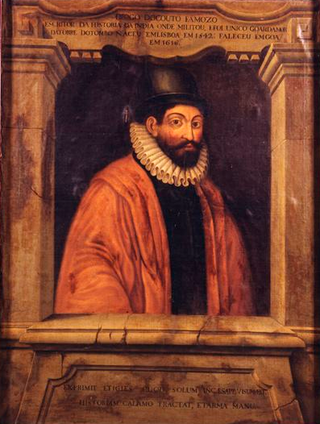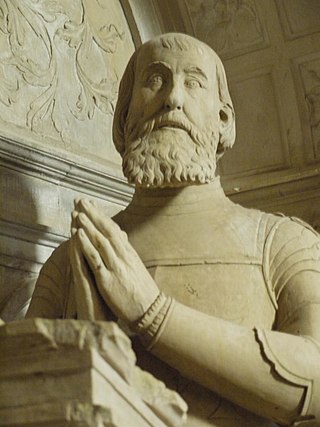
Dom Francisco de Almeida, also known as the Great Dom Francisco, was a Portuguese nobleman, soldier and explorer. He distinguished himself as a counsellor to King John II of Portugal and later in the wars against the Moors and in the conquest of Granada in 1492. In 1505 he was appointed as the first governor and viceroy of the Portuguese State of India. Almeida is credited with establishing Portuguese hegemony in the Indian Ocean with his victory at the naval Battle of Diu in 1509. Before Almeida returned to Portugal he lost his life in a conflict with indigenous people at the Cape of Good Hope in 1510. His only son Lourenço de Almeida had previously been killed in the Battle of Chaul.

João Gonçalves Zarco was a Portuguese explorer who established settlements and recognition of the Madeira Islands, and was appointed first captain of Funchal by Henry the Navigator.
Bartolomeu Perestrello, 1st Capitão Donatário, Lord and Governor of the Island of Porto Santo was a Portuguese navigator and explorer that is claimed to have discovered and populated Porto Santo Island (1419) together with João Gonçalves Zarco and Tristão Vaz Teixeira. The account of his participation in the discovery is disputed by some historians.

Duarte Pacheco Pereira, called the Portuguese Achilles by the poet Camões, was a Portuguese sea captain, soldier, explorer and cartographer. He travelled particularly in the central Atlantic Ocean west of the Cape Verde islands, along the coast of West Africa and to India. His accomplishments in strategic warfare, exploration, mathematics and astronomy were of an exceptional level.

This is a historical timeline of Portugal's Second Dynasty.
Ana de Mendonça (1460-1542) was a maid of the Queen regnant of Castile, Joanna la Beltraneja, and a mistress of King John II of Portugal, who was also Master of the Order of Saint James 1470-1492. They had one son, Jorge de Lencastre, Duke of Coimbra and Master of the Military Order of Saint James of the Sword. He married D. Isabel Colón's sister-in-law.

Lopo Soares de Albergaria was the fifth captain-major of the Portuguese Gold Coast and third governor of Portuguese India, having reached India in 1515 to succeed Afonso de Albuquerque as governor.
Dom Fernando de Almada, 2nd Count of Avranches was a Portuguese nobleman.
Rafael Perestrello was a Portuguese explorer and a cousin of Filipa Moniz Perestrello, the wife of explorer Christopher Columbus. He is best known for landing on the southern shores of mainland China in 1516 and 1517 to trade in Guangzhou, after the Portuguese explorer Jorge Álvares landed on Lintin Island within the Pearl River estuary in May 1513. Rafael also served as a trader and naval ship captain for the Portuguese in Sumatra and Portuguese-conquered Malacca.
Count of Abrantes was a Portuguese title of nobility created by a royal decree, dated from June 13, 1476, by King Afonso V of Portugal, and granted to his 4th cousin, Lopo de Almeida.

Diogo do Couto was a Portuguese historian.
The high office of Admiral of the Kingdom of Portugal as the head of the Portuguese navy was created by King Denis of Portugal in 1317 for the Genoese nobleman and naval officer Manuel Pessanha. Although there is evidence that such a title existed before, it seems to have been of only a temporary character, for fleets assembled in times of war. The exception was perhaps Nuno Fernandes Cogominho who seems to have been appointed admiral by King Denis in 1307, and still had that title at his death in 1316, although the conditions are unclear. Nonetheless, Manuel Pessanha was the first person known to hold the title of Almirante-mor as a permanent office for a permanent fleet. All the king's galleys were under his jurisdiction. The conditions of the Pessanha's title stipulated that he must maintain a corps of at least 20 Genoese naval officers at all times and was obliged to serve the king in military service on land as well as sea.
Pedro Correia da Cunha was a Portuguese nobleman who was the Second Donatary-Captain of Porto Santo, and the 1st Donatary-Captain of the island of Graciosa, in the Portuguese archipelago of the Azores.

Fernão Gomes de Lemos was the third and last Captain of Portuguese Ceylon. Lemos succeeded Lopo de Brito and was appointed in 1522 under John III of Portugal, he was Captain until 1524. In 1524 when he left as Captain, the office was left vacant until 1551, where the office was succeeded by Captain-majors of Portuguese Ceylon. He was also Portuguese Ambassador to Persia, appointed by Afonso de Albuquerque in 1515.

The Sousa family is an ancient Portuguese noble family. It is considered to be one of the eldest and most noble houses in the Kingdom of Portugal.

The Quinta dos Lagares d'El-Rei, is a quinta and manor house on the Portuguese estate of Quinta dos Lagares d'El-Rei, part of the Senhorio dos Lagares d'El-Rei, a feudal fiefdom, seated in the civil parish of Alvalade, in the municipality of Lisbon.

Lopo de Almeida (1416–1486) was the first Count of Abrantes bestowed with the title on June 13, 1476 by King D. Afonso V of Portugal.

Duarte Galvão was a Portuguese courtier, diplomat and chronicler.

Duarte de Lemos, 3rd Lord of Trofa, was a 16th century Portuguese nobleman, soldier and donatary. In Brazil, he was Lord of the island of Santo Antônio, the present-day island of Vitória, where the capital of the state of Espírito Santo was founded.











